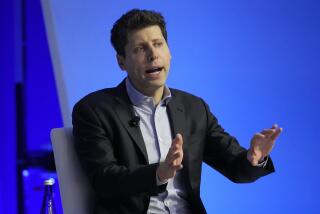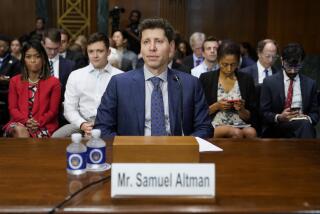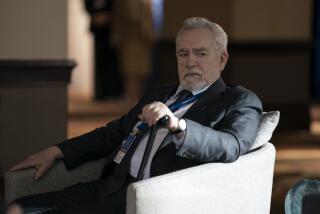GENE LU : PC Successes Adding Up Fast : Advanced Logic Research Sees Still More Growth Ahead
- Share via
Gene Lu’s boyish looks and modest manner seem more fitting for a university graduate student than for the head of a fast-growing personal computer company. But Lu, 35, the founder and president of Advanced Logic Research of Irvine, is beginning to get a sprinkling of gray in his jet-black hair--evidence, perhaps, of the strains of running an $80-million company in a fiercely competitive industry.
Since its founding in 1984, ALR has established itself as one of the better-known players among the several dozen companies producing IBM-compatible personal computers. ALR has stood out by producing super-fast PCs that have won many rave reviews from the computer trade press.
ALR also has won a reputation as the first to market new technology. Last year, it was the first to sell a PC using the advanced 80386 microchip from Intel, and earlier this month, it was the first PC maker to announce plans for a machine to be built around a new industry design known as EISA, or Extended Industry Standard Architecture.
ALR is a privately held company controlled by Wearne Bros. Ltd., a large Singapore-based trading concern. Wearne owns 61% of ALR; Lu, with about 25%, is the second-largest shareholder.
ALR sales have been zooming, going from less than $10 million in 1986 to $40 million last year. The company expects to post double that number--$80 million--when it closes the books on its current fiscal year at the end of this month.
Lu, the son of a Taiwanese engineer, immigrated to the United States with his family when he was 9 years old, and he grew up in El Monte. He earned his engineering degree at Cal Poly Pomona. He now lives in San Clemente with his wife, Terry, who works part-time in the ALR personnel department, and their three children.
In a recent interview with Times staff writer David Olmos, Lu discussed his business strategy and his plans for ALR.
Q. ALR seems to have come out of nowhere in the last two years, growing very quickly. How did you do it?
A. I think that’s one of the great things about the industry we’re in. It has the ability to be very explosive. We didn’t just come out of nowhere in the last two years. Actually, we’ve been trying real hard to come out of somewhere the past five years. It’s only been, as you say, the last two years that people have been noticing us and taking us more seriously.
How did we do it? It’s been the same formula from day one: We leverage our technology to grow our business. As the technology race has become more heated, we’ve been able to stay ahead of the pack and continually demonstrate that we’re better than anybody in the world as far as our PCs are concerned.
Q. When did you decide to start your own company, and why?
A. I was an engineer at National Advanced Systems in north San Diego County. The project I was working on there was a mainframe PC project. Unfortunately, in 1984 the semiconductor industry was in hard times, and a lot of projects got delayed. Our project was put on hold. It was a tough thing for engineers and anybody who has a lot of ambition to sit around and wait for a project to be restarted. And that’s when I left.
Q. You left with the idea of starting your own company?
A. Yes. In 1984, the IBM-compatible industry--or that dirty word clones that people used to use--was around and very prevalent. It was a tough time for a small company to get started; but it really is one of the last frontiers for a small company to get started where an individual or a team of people can make a difference and grow to be a large-sized company. We’re very proud to say we haven’t had a losing quarter since we started the business. We’ve had 100% to 300% growth per year and still been able to maintain profitability.
Q. Has there been a turning point for this company in its growth so far?
A. It seems like every day should be a turning point. People always come up to me and say, “Gee, you’re now facing some of the toughest times and your company is now having to change to the next size. It seems I heard that same statement when we were at $1 million going to $5 million, at $5 million going to $15 million. We’ve gone from $15 million to $40 million and now to $80 million, and now our goal is $200 million. That’s our goal. It’s always changing in our business. That’s the fun part of this computer industry and the tough part of this industry. It’s always changing. It’s very fluid and dynamic. You have to be very quick to market with very good products. You don’t have a lot of time to change the mistakes you make early on.
Q. How important was it to your company to have the investment from Wearne Bros.?
A. If it was not for Wearne, we would not be here today. Any company that is manufacturing-oriented should be aware of growth. If you want to grow each year, you better make sure you are well capitalized. You need that cash flow to keep the company going. Wearne was an important ingredient in the growth of our business.
Q. Has the relationship with Wearne been a good one?
A. It’s been a fantastic relationship. They are a very intelligent investor. They have faith in what we’re doing and give us enough room to make the mistakes that we need to make and to succeed when we do. They’re really more in the background to give us the financial support we need.
Q. ALR’s products have continued to win rave reviews for their technical excellence from trade publications. Despite increasing sales, ALR is still a relatively minor player in the PC market. What are you doing to become a bigger force in the industry?
A. I think we’ve been a minor force in PC industry from standpoint of industrywide sales; but we’ve been a major force in the PC industry in the high-end PC niche market--the workstations and file servers. We’re more well-known in the corporate back rooms, where the data processing manager puts our PCs in to use more like a minicomputer. The people in the front office are using the lower-cost PCs. That’s about to change for us, however, because our new PowerFlex product has taken the market by storm.
Q. What changes do you see in the personal computer industry over the next three to five years?
A. Personal computers are becoming (increasingly powerful) office workstations. Even IBM has stopped calling them PCs and now calls its machines workstations. I think corporate departments and even small businesses are seriously looking at PCs as the office automation equipment of the future. It’s no longer simply a personal computer. I also think PCs are encroaching into the minicomputer arena and filling that role very well.
Q. How will these changes affect ALR?
A. It gives us a very viable future. The largest business segment out there is the office automation area. The background of myself and some of the other people in this company was in the minicomputer industry. (Lu is a former engineer for Computer Automation, a minicomputer maker.) We all came from that industry, and that’s why we are very optimistic about our company and our produts.
Q. What’s the biggest challenge facing your company?
A. I think our biggest challenge concerns staffing and personnel. You may have the latest and greatest technology, but tomorrow somebody else might have better technology than you.
Q. What’s ALR’s biggest weakness right now?
A. If we did have one, I wouldn’t tell anybody right now. Every company has its weaknesses, and we’re a company that is always trying to address our problems. I think our main problems generally have to do with growing as rapidly as we have.
Q. Some industry pundits have said that consolidation in the computer industry will force smaller manufacturers to either merge with larger ones or go out of business. Are there any merger plans on the horizon for ALR?
A. No, that’s not a possibility for us. ALR is very ambitious, very aggressive. Our intent is to grow our business and be a major force in the PC industry. We want to open our blinders a bit and grow beyond the niche market we’ve been concentating on. We want to grow, not so much by mergers, but when we get to a certain size we may be looking to make acquisitions.
Q. Has ALR been approached by other companies about a merger?
A. No. We’ve been approached by minicomputer companies (about licensing agreements). We currently have two licenses of our computer designs to a well-known minicomputer company--one of the five largest computer companies in the world. We’re designing products for them. So people are coming to us for our technical expertise.
Q. Can you identify that minicomputer company?
A. No, I can’t now.
Q. You’ve said before that ALR’s goal is to become a publicly held company. When do you plan to go public?
A. Currently, we’re looking at going public after we complete our fiscal 1990 first quarter, which ends in December. We’ll probably utilize those revenue numbers to do a public offering. If everything’s on schedule, we probably won’t be a public company until February or March.
Q. Do you think going public will change the company’s priorities, since you’ll then have to worry about what Wall Street thinks?
A. I think we’ve already been a very public company from the standpoint of how we communicate with the Wall Street analysts and newspaper and magazine editors, even though we’re a private company. We want to be understood and have people know which direction we’re going.
Q. How much money do you hope to raise in the public offering?
A. I don’t have an exact figure. It will be more than sufficient for us to finance our business through 1990 and parts of 1991. We do have the benefit of Wearne’s being an important player. Wearne does not have any intent to sell out their holding in this offering. They are with us for the long term. We have them as a big brother on our side. We’re also talking with some minicomputer companies that are interested in investing in our company. I wouldn’t be surprised if soon we have two big brothers on our side, plus being a public company.
Q. One of the key issues for ALR has been its ability to get its products sold by the major computer chains and dealers. How much success have you had lately on that front?
A. For the past four years, we’ve only sold through dealers and resellers. Recently we signed on three major PC distributors--Ingram Micro D, Softsel and Gates FA. These are the premier distributors in PC industry. They offer our products to be available to almost every dealer in the country. We’ve been very successful in opening our distribution channel.
Q. How are your sales divided between the United States and overseas?
A. Ninety percent in the U.S. and the rest overseas. Right now, we have very few sales in Europe, and we’re just starting in Canada.
Q. ALR has always seemed to make an effort to be first to the market with new technology. Is being first to market important to you, and, if so, why?
A. I think the fact we invest in technology often allows us to be first to market. I believed being early to market is important, but I don’t believe always being first to market is critical.
It’s our way of paying back to the industry what we’ve taken from the industry. That is, to invest in future products, research and design to keep us competitive in the future, but also as a way for customers to enjoy the new technology. This is a company that is not only building compatible PCs but also investing in research and development. We have research in our company name, and that didn’t go in there for it to sound good. It’s an indication of what our intentions are for this company.
Q. Gene, you own about 25% of the company’s stock. Is this public offering going to make you a wealthy man?
A. I think as most public offerings are, the founders usually do not sell out in the early stages. I think that will be consistent with what we’re doing here. It’s all on paper.
Q. Would you like your company to be larger than your competitor down the street, AST Research, someday?
A. It’s a personal goal of mine. We have to be bigger not only from a revenue standpoint, but we want to be a success story that does not peak out and die down. We intend to be in this computer business for the long term. Our ambitions are very high. If you asked me what my wildest dream is 10 years from now, I would tell you I’d like to be the size of Compaq. Everybody has ambitions and as long as you can keep them in the right perspective, it’s healthy.






